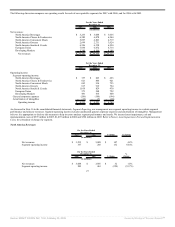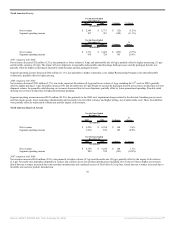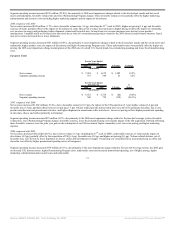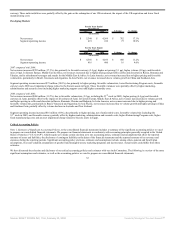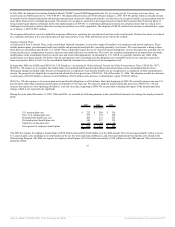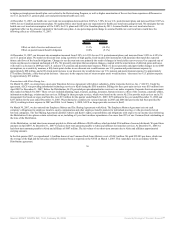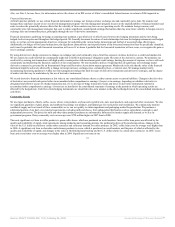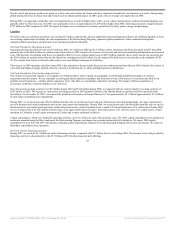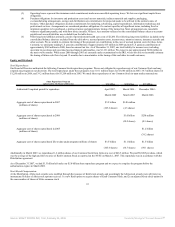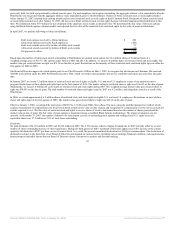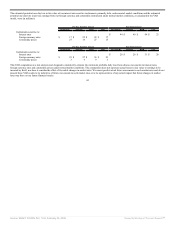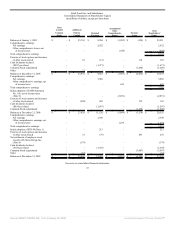Kraft 2008 Annual Report Download - page 39
Download and view the complete annual report
Please find page 39 of the 2008 Kraft annual report below. You can navigate through the pages in the report by either clicking on the pages listed below, or by using the keyword search tool below to find specific information within the annual report.
Also, see Note 5, Income Taxes, for information on how the closure of an IRS review of Altria’s consolidated federal income tax return in 2006 impacted us.
Financial Instruments:
As Kraft operates globally, we use certain financial instruments to manage our foreign currency exchange rate and commodity price risks. We monitor and
manage these exposures as part of our overall risk-management program. Our risk management program focuses on the unpredictability of financial markets and
seeks to reduce the potentially adverse effects that the volatility of these markets may have on our operating results. We maintain foreign currency and
commodity price risk management strategies that seek to reduce significant, unanticipated earnings fluctuations that may arise from volatility in foreign currency
exchange rates and commodity prices, principally through the use of derivative instruments.
Financial instruments qualifying for hedge accounting must maintain a specified level of effectiveness between the hedging instrument and the item being
hedged, both at inception and throughout the hedged period. We formally document the nature of and relationships between the hedging instruments and hedged
items, as well as our risk-management objectives, strategies for undertaking the various hedge transactions and method of assessing hedge effectiveness.
Additionally, for hedges of forecasted transactions, the significant characteristics and expected terms of the forecasted transaction must be specifically identified,
and it must be probable that each forecasted transaction will occur. If we deem it probable that the forecasted transaction will not occur, we recognize the gain or
loss in earnings currently.
By using derivatives to hedge exposures to changes in exchange rates and commodity prices, Kraft has exposure on these derivatives to credit and market risk.
We are exposed to credit risk that the counterparty might fail to fulfill its performance obligations under the terms of the derivative contract. We minimize our
credit risk by entering into transactions with high-quality counterparties with investment grade credit ratings, limiting the amount of exposure we have with each
counterparty and monitoring the financial condition of our counterparties. We also maintain a policy of requiring that all significant, non-exchange traded
derivative contracts be governed by an International Swaps and Derivatives Association master agreement. Market risk is the risk that the value of the financial
instrument might be adversely affected by a change in foreign currency exchange rates, commodity prices, or interest rates. We manage market risk by
incorporating monitoring parameters within our risk management strategy that limit the types of derivative instruments and derivative strategies, and the degree
of market risk that may be undertaken by the use of derivative instruments.
We record derivative financial instruments at fair value in our consolidated balance sheets as either current assets or current liabilities. Changes in the fair value
of derivatives are recorded each period either in accumulated other comprehensive earnings / (losses) or in earnings, depending on whether a derivative is
designated and effective as part of a hedge transaction and, if it is, the type of hedge transaction. Gains and losses on derivative instruments reported in
accumulated other comprehensive earnings / (losses) are reclassified to the consolidated statement of earnings in the periods in which operating results are
affected by the hedged item. Cash flows from hedging instruments are classified in the same manner as the affected hedged item in the consolidated statements of
cash flows.
Commodity Trends
We are major purchasers of dairy, coffee, cocoa, wheat, corn products, soybean and vegetable oils, nuts, meat products, and sugar and other sweeteners. We also
use significant quantities of glass, plastic and cardboard to package our products, and natural gas for our factories and warehouses. We continuously monitor
worldwide supply and cost trends of these commodities so we can act quickly to obtain ingredients and packaging needed for production. We purchase a
substantial portion of our dairy raw material requirements, including milk and cheese, from independent third parties such as agricultural cooperatives and
independent processors. The prices for milk and other dairy product purchases are substantially influenced by market supply and demand, as well as by
government programs. Dairy commodity costs on average were $750 million higher in 2007 than in 2006.
The most significant cost item in coffee products is green coffee beans, which are purchased on world markets. Green coffee bean prices are affected by the
quality and availability of supply, trade agreements among producing and consuming nations, the unilateral policies of the producing nations, changes in the
value of the U.S. dollar in relation to certain other currencies and consumer demand for coffee products. In 2007, coffee bean costs on average were higher than
in 2006. A significant cost item in chocolate confectionery products is cocoa, which is purchased on world markets, and the price of which is affected by the
quality and availability of supply and changes in the value of the British pound sterling and the U.S. dollar relative to certain other currencies. In 2007, cocoa
bean and cocoa butter costs on average were higher than in 2006. Significant cost items in our
37
Source: KRAFT FOODS INC, 10-K, February 25, 2008 Powered by Morningstar® Document Research℠


